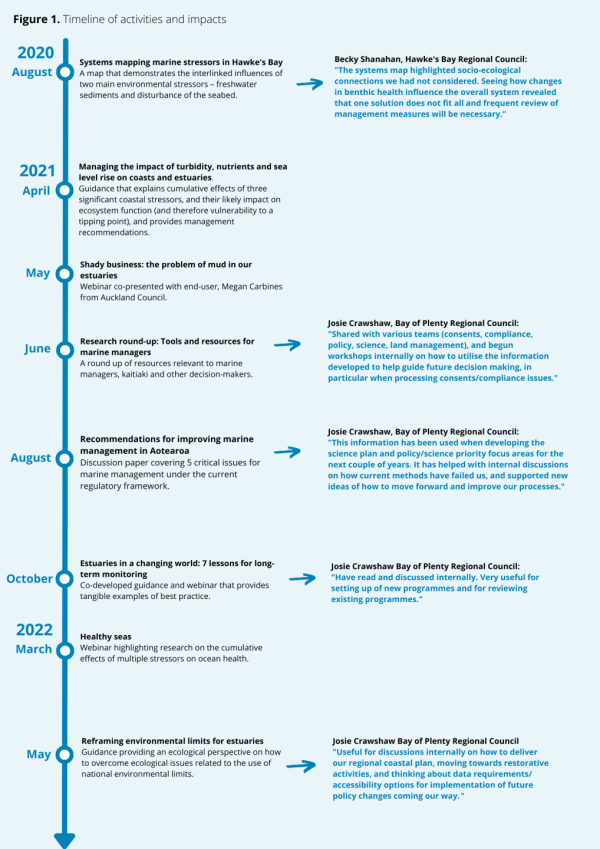- Summary
Enabling cumulative effects management
This impact case study demonstrates how our research is having a real-time impact on how our marine environment is managed to reduce the impact of cumulative effects (August 2022)
Marine managers and kaitiaki know that to effectively improve marine management, we must tackle multiple stressors and their cumulative effects (CE). However, until now they’ve had limited tools to help do this.
We have drawn together and translated insights and recommendations from across our 75 research projects into user-focused resources to enable more effective CE management (Figure 1). These are user-focused and practical, including guidance documents, discussion papers and webinars. These resources have been well-received and are being on-shared by end-users, which is a critical step to wide implementation.
“The review of our coastal plan involves many people who haven’t heard of, or are less familiar with, ecosystem-based management and the various challenges of managing cumulative effects. The resources developed by the Challenge, both written and visual, provide concise entry points to many who would otherwise not access this subject matter. It’s heartening to see science ‘thought leaders’ produce these types of resources in addition to their journal publication, increasing access to applied science and helping make it even more applied and useful. The value of Sustainable Seas will carry on long after the programme is completed.” Michael Townsend, Waikato Regional Council.
Sharing our knowledge
Our guidance documents are either co-developed and/or tested with end-users to ensure the information, format and/or recommendations are relevant, fit-for-purpose and useful.
Reframing environmental limits for estuaries – An ecological perspective on how to overcome issues related to the use of national environmental limits. It was created following workshops with MfE and discussions with Minister Parker and refined with input from the Regional Councils’ Coastal Special Interest Group. The Challenge synthesis team worked together to ensure the information was in the right format and shared where and when it was needed. It draws on knowledge created over years, across different projects, and from other engagement activities that put our research into action (eg our written and oral submissions to the Natural and Built Environments Bill consultation).
“Useful for discussions on how to deliver our regional coastal plan, moving towards restorative activities, and thinking about data requirements/accessibility options for implementation of future policy changes coming our way.” Josie Crawshaw, Bay of Plenty Regional Council.
Monitoring estuaries in a changing world: lessons for designing monitoring programmes – This guidance shares tangible estuary monitoring best practices and is part of a suite of resources about CE and estuarine monitoring. It was co-developed with Megan Carbines, a Principal Scientist at Auckland Council; then disseminated via an accompanying webinar targeted to end-users, as well as our usual channels (website, newsletter, social media). Megan co-presented the webinar, giving an end-user perspective. Attendees were sent the guidance in advance, which enabled a longer, richer Q&A discussion session. We received positive feedback on the webinar and the guidance.
Recommendations for improving marine management in Aotearoa – This discussion paper covers five critical issues for marine management under the current regulatory framework and recommendations to address each issue.
Webinars
End-users tell us that webinars are one of the main ways they access our research findings. They provide an opportunity to directly interact with experts through a Q&A discussion, deepening their understanding. Webinars on CE and how to manage them received higher than average attendance, and YouTube views indicate that those who registered but could not make it watch the recording later. Attendees are highly engaged – and decision-makers have used what they have learnt to inform their coastal plans, data requirements and monitoring programs (Figure 1).
Hawke’s Bay Regional study
In collaboration with the Hawke's Bay Marine and Coastal Group and iwi, we mapped two environmental stressors in Hawke's Bay, land-derived sedimentation and loss of benthic (seabed) structure, and their interactions. We then modelled the effectiveness of potential management scenarios for these stressors on seabed recovery.
“While we know the system is complex, the systems map highlighted socio-ecological connections we had not considered. Seeing how changes in benthic health influence the overall system revealed that one solution does not fit all and frequent review of management measures will be necessary.” Becky Shanahan, Hawke's Bay Regional Council.
Contact
Conrad Pilditch [email protected]
Research organisations
Sustainable Seas Synthesis Team
